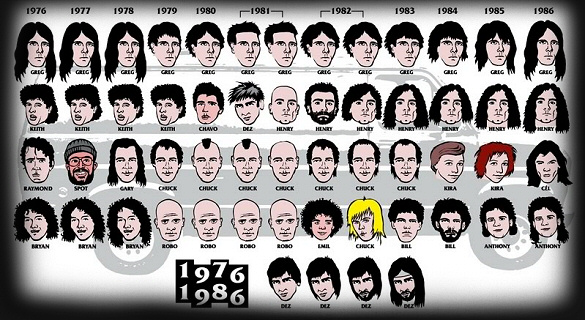Spray Paint the Walls – The Story Of Black Flag
January 24, 2010
 Once while in high school I was discussing the legacy and mysterious aura of Black Flag with a couple of friends and I paused to say "Dude, there's only so much that we know about Black Flag." At the time this statement was fairly accurate. Henry Rollins had published his tour diaries from when he was in the band in Get In The Van but otherwise there was seemingly no information available about Black Flag that was readily available. Greg Ginn and Chuck Dukowski were out of the limelight, Keith Morris was playing with the reunited Circle Jerks but his short tenure with Black Flag remained mysterious, Dez Cadena was not yet playing with the "Misfits," and Ron Reyes seemed to have fallen off of the face of the Earth. Black Flag had broken up years before any of us had even heard of punk rock and it wasn't hard to imagine that somewhere there was a vault full of classified information on the band. It seemed strange that such an iconic and influential band had left behind these incredibly diverse and hard hitting recordings but otherwise were largely unaccounted for.
Once while in high school I was discussing the legacy and mysterious aura of Black Flag with a couple of friends and I paused to say "Dude, there's only so much that we know about Black Flag." At the time this statement was fairly accurate. Henry Rollins had published his tour diaries from when he was in the band in Get In The Van but otherwise there was seemingly no information available about Black Flag that was readily available. Greg Ginn and Chuck Dukowski were out of the limelight, Keith Morris was playing with the reunited Circle Jerks but his short tenure with Black Flag remained mysterious, Dez Cadena was not yet playing with the "Misfits," and Ron Reyes seemed to have fallen off of the face of the Earth. Black Flag had broken up years before any of us had even heard of punk rock and it wasn't hard to imagine that somewhere there was a vault full of classified information on the band. It seemed strange that such an iconic and influential band had left behind these incredibly diverse and hard hitting recordings but otherwise were largely unaccounted for.
Today things are a bit different. As the result strange reunion shows, and interviews in the American Hardcore movie/book,much more information is out there about Black Flag now. With Stevie Chick's new four hundred page book, Spray Paint The Walls, a wealth of new stories from many different perspectives have now helped to fill in many of the holes that that were missing in Black Flag's history. Through exclusive interviews with Keith Morris, Chuck Dukowski, Ron Reyes, Kira Roessler, and members of the Black Flag/SST family such as Mike Watt, Mugger, and Glen E. Friedman, this book helps to tell the story behind hardcore Punk's most influential band.
The most interesting part of Spray Paint The Walls is the beginning of the book where Chick explains how all of the members of Black Flag and their crew came together in the early years. In the past there never seemed to be too much documentation of the "First Four Years" era of Flag and the Punk rock community that the band helped to harvest outside of Los Angeles in the South Bay region of Southern California. There is a lot of emphasis on the relationships between the band members before Black Flag formed and the evolution of the band between their first three singers. Keith Morris and Ron Reyes are particularly revealing in this part of the book and they help to explain what it was like when the band was rehearsing and often living in an abandoned Church in Hermosa Beach. They explain how having this centralized location helped to establish a tight knit connection between band members and their early fans. It also tells the story of the kinship formed between Black Flag and bands like the Minutemen, The Last and Red Cross.

While Henry Rollins' career with Black Flag was already well documented from his own point of view, Spray Paint offers a more complete perspective. Kira Roessler, Chuck Dukowski, Mugger, and Glen E. Friedman in particular add valuable insight into the group psychology of the band. Greg Ginn is often shown in an unflattering way, but perhaps if he had been willing to participate in an interview with the author he would have had an opportunity to tell his side of the story. Nevertheless he is generally described as a control freak who was resentful towards Henry Rollins for getting the most attention as the band's front man. It seems that he struggled to deal with other human beings in an artistic setting and that ultimately he saw Black Flag as a product of his own vision rather than a group effort.
Overall Spray Paint The Walls provides an engaging read and offers a professional and intellectual look at Black Flag, but it does have its weaknesses. Predictably it depicts Punks from Huntington Beach ("Huntingdon" as Chick spells it) and the rest of Orange County as mindless and violent without offering a single perspective from anyone who was involved in the Orange County Punk scene. While there certainly is some truth behind this stereotype, Chick fails to recognize that H.B.'s helped Black Flag to create their own scene while they were largely often overlooked or rejected by Hollywood Punks. The book also does tend to become a bit redundant in that it repeatedly tells the story of how Black Flag followed a formula where they recorded albums that alienated their fans, played in cities where they were mistreated by their audiences, and then put out another even more experimental record just as people were starting to appreciate the sound of their most recent output. While Chick is simply telling the story of how things happened, perhaps this notion could have been discussed with fewer redundancies.
All criticisms aside, Spray Paint is a long overdue look at Black Flag and their complete legacy. Without this book a large and significant gap would be missing from the story of punk rock and Stevie Chick has managed to collect invaluable interviews and information about a band who otherwise have been shrouded in some degree of mystery. The story of Black Flag is one that is inspiring for any musician who has ever tried to deviate from the norm and play music their own way, and Chick has delivered this story in an interesting and thought provoking way.
Here is a source for the book:
Spray Paint the Walls - The Story Of Black Flag from www.amazon.com
-Ditch-









